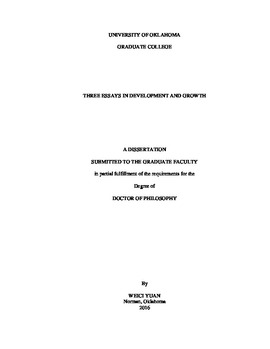| dc.description.abstract | My research explores important issues associated with development and growth. Chapter 1 aims to obtain an accurate estimate of China's intergenerational income mobility and to present evidence on its distributional pattern. Using panel data from the China Health and Nutrition Survey (CHNS) over the period 1989—2009, I find that China is less mobile than most developed countries. Then, I employ five different approaches to investigate the distributional pattern of China's intergenerational mobility across income levels. The results suggest that poor families have relatively high mobility, indicating opportunities for the poor children to escape poverty. Finally, I show that while wealthy fathers are likely to pass on their favorable economic status to their sons, rich sons come from a very wide range of family economic backgrounds.
In the second chapter of my dissertation, conspicuous consumption in China is studied. Conspicuous consumption, also called visible expenditures, conveys higher socioeconomic status and may help individuals differentiate themselves in the marriage market when there is competition for partners and imperfect information. I examine a unique dataset of automobile purchasers in China to investigate the extent to which skewed sex ratios influence expenditure decisions for this highly visible commodity. Using a triple difference approach, I show that unmarried male consumers who face an unfavorable sex ratio purchase more expensive, luxury vehicles than their married peers. Lower income borrowers and those residing in regions with the worst sex ratios exhibit the largest relative degree of conspicuous consumption. In addition to the direct cost of consumption signaling, I demonstrate this behavior generates negative externalities in the form of lower average fuel economy and higher average vehicle weight. As it has worsened sex ratios, status competition and the associated negative repercussions I identify represent unintended consequences of China’s one-child policy.
Chapter 3 evaluates the causal effect of equity market liberalization in sixty-five countries that have adopted this policy during 1980-2011. While previous research has been devoted to liberalization cases prior to 2000, I extend the data through 2011, which leads to a roughly 50% increase in the number of cases. I first replicate the results in Bekaert et al. (2005) and then extend their analysis to the present. I find that the previously estimated growth effects remain significant in the updated sample. Next, I seek to address issues of endogenous policy selection that existing literature has failed to handle adequately. To do this, I model the liberalization decisions using a Cox proportional hazard regression and combine propensity score matching with difference-in-difference methods to obtain an unbiased estimate of the treatment effects of liberalization. My results suggest that equity market liberalizations generate growth effects that are far more persistent than previously documented. | en_US |
